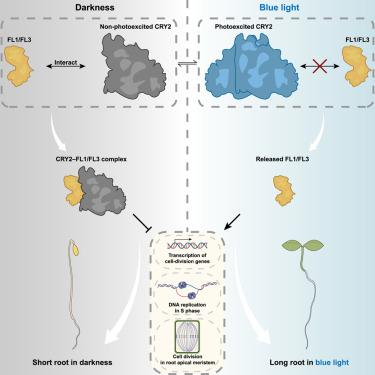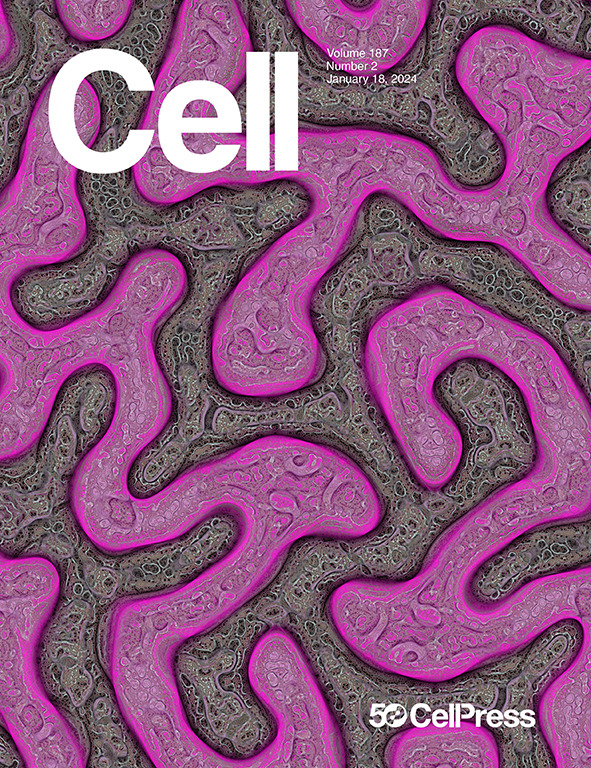拟南芥蓝光光敏感受器 CRY2 在黑暗中具有抑制根系生长的活性
IF 42.5
1区 生物学
Q1 BIOCHEMISTRY & MOLECULAR BIOLOGY
引用次数: 0
摘要
隐色体(CRYs)是一种蓝光受体,能调节植物生长的各个方面。然而,非光电激发的 CRYs 在黑暗或非蓝光条件下是否以及如何发挥作用尚不清楚。在这里,我们发现 CRY2 甚至在黑暗条件下也会影响拟南芥的转录组,从而揭示了它的非经典功能。CRY2 可抑制根尖分生组织中的细胞分裂,从而在黑暗条件下下调根的伸长。蓝光寡聚了 CRY2,从而抑制了根的伸长。CRY2与FORKED-LIKE 1(FL1)和FL3发生物理相互作用,这些相互作用受到蓝光的抑制,只有单体而非二聚体CRY2能够发生相互作用。FL1 和 FL3 与细胞分裂基因的染色质结合,促进其转录。在黑暗中,CRY2 与 FL 的物理相互作用抑制了这种促进生长的活性。植物在进化过程中同时感知蓝光和暗光线索,通过对古老的光受体的经济和二分使用,协调地上和地下器官中相互竞争的发育过程的激活和抑制。本文章由计算机程序翻译,如有差异,请以英文原文为准。

The Arabidopsis blue-light photoreceptor CRY2 is active in darkness to inhibit root growth
Cryptochromes (CRYs) are blue-light receptors that regulate diverse aspects of plant growth. However, whether and how non-photoexcited CRYs function in darkness or non-blue-light conditions is unknown. Here, we show that CRY2 affects the Arabidopsis transcriptome even in darkness, revealing a non-canonical function. CRY2 suppresses cell division in the root apical meristem to downregulate root elongation in darkness. Blue-light oligomerizes CRY2 to de-repress root elongation. CRY2 physically interacts with FORKED-LIKE 1 (FL1) and FL3, and these interactions are inhibited by blue light, with only monomeric but not dimeric CRY2 able to interact. FL1 and FL3 associate with the chromatin of cell division genes to facilitate their transcription. This pro-growth activity is inhibited by CRY2’s physical interaction with FLs in darkness. Plants have evolved to perceive both blue-light and dark cues to coordinate activation and repression of competing developmental processes in above- and below-ground organs through economical and dichotomous use of ancient light receptors.
求助全文
通过发布文献求助,成功后即可免费获取论文全文。
去求助
来源期刊

Cell
生物-生化与分子生物学
CiteScore
110.00
自引率
0.80%
发文量
396
审稿时长
2 months
期刊介绍:
Cells is an international, peer-reviewed, open access journal that focuses on cell biology, molecular biology, and biophysics. It is affiliated with several societies, including the Spanish Society for Biochemistry and Molecular Biology (SEBBM), Nordic Autophagy Society (NAS), Spanish Society of Hematology and Hemotherapy (SEHH), and Society for Regenerative Medicine (Russian Federation) (RPO).
The journal publishes research findings of significant importance in various areas of experimental biology, such as cell biology, molecular biology, neuroscience, immunology, virology, microbiology, cancer, human genetics, systems biology, signaling, and disease mechanisms and therapeutics. The primary criterion for considering papers is whether the results contribute to significant conceptual advances or raise thought-provoking questions and hypotheses related to interesting and important biological inquiries.
In addition to primary research articles presented in four formats, Cells also features review and opinion articles in its "leading edge" section, discussing recent research advancements and topics of interest to its wide readership.
 求助内容:
求助内容: 应助结果提醒方式:
应助结果提醒方式:


